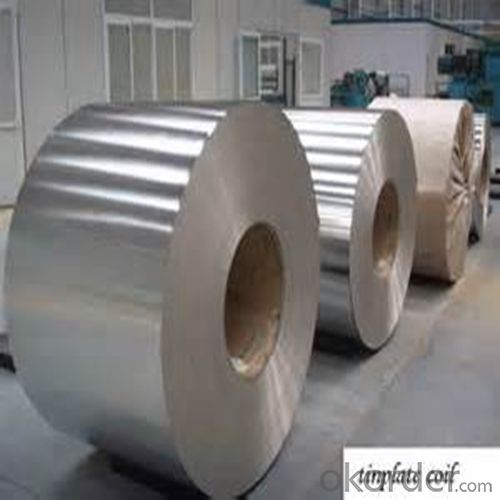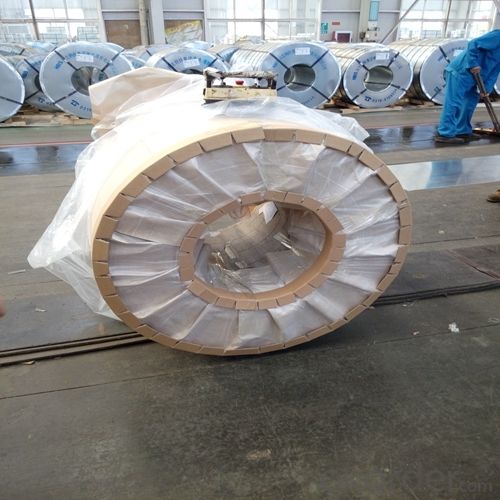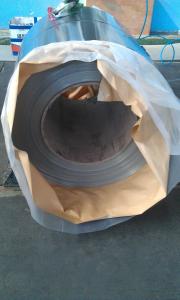Electrolytic Tinplate for Metal Package of Industrial or Chemical Use
- Loading Port:
- Shanghai
- Payment Terms:
- TT OR LC
- Min Order Qty:
- 25 m.t.
- Supply Capability:
- 30000 m.t./month
OKorder Service Pledge
OKorder Financial Service
You Might Also Like
Item specifice
1.Structure of Electrolytic Tinplate for Metal Package of Industrial or Chemical Use Description
Tinplate, thin steel sheet with a coating of tin applied either by dipping in molten metal or by electrolytic deposition; almost all tinplate is now produced by the latter process. Tinplate made by this process is essentially a sandwich in which the central core is strip steel. This core is cleaned in a pickling solution and then fed through tanks containing electrolyte, where tin is deposited on both sides. As the strip passes between high-frequency electric induction coils, it is heated so that the tin coating melts and flows to form a lustrous coat.
2.Main Features of the Electrolytic Tinplate for Metal Package of Industrial or Chemical Use
Appearance – Tinplate is characterized by its beautiful metallic luster. Products with various kinds of surface roughness are produced by selecting the surface finish of the substrate steel sheet.
Paintability and printability – Tinplates have excellent paintability and printability. Printing is beautifully finished using various lacquers and inks.
Formability and strength – Tinplates have got very good formability and strength. By selecting a proper temper grade, appropriate formability is obtained for different applications as well as the required strength after forming.
Corrosion resistance – Tinplate has got good corrosion resistance. By selecting a proper coating weight, appropriate corrosion resistance is obtained against container contents. Coated items should meet 24 hour 5 % salt spray requirement.
Solderability and weldability – Tinplates can be joined both by soldering or welding. These properties of tinplate are used for making various types of cans.
Hygienic – Tin coating provides good and non toxic barrier properties to protect food products from impurities, bacteria, moisture, light and odours.
Safe – Tinplate being low weight and high strength makes food cans easy to ship and transport.
Eco friendly – Tinplate offers 100 % recyclability.
Tin is not good for low temperature applications since it changes structure and loses adhesion when exposed to temperatures below – 40 deg C.
3.Electrolytic Tinplate for Metal Package of Industrial or Chemical Use Images


4.Electrolytic Tinplate for Metal Package of Industrial or Chemical Use Specification
Specification of :
Standard: ISO 11949 -1995, GB/T2520-2000,JIS G3303,ASTM A623, BS EN 10202
Material: MR,SPCC
Thickness:0.15mm - 0.50mm
Width: 600mm -1150mm
Temper: T1-T5
Annealing: BA & CA
Coil Inner Diameter: 508mm
Weight: 6-10 tons/coil 1~1.7 tons/sheets bundle
Passivation:311
Oil: DOS
Surface: Finish,bright,stone,matte,silver
5.FAQ of Electrolytic Tinplate for Metal Package of Industrial or Chemical Use
- What is tinning and how does it work?
Tinning is the process of thinly coating sheets of wrought iron or steel with tin, and the resulting product is known as tinplate. It is most often used to prevent rust.
- Do you only have prime quality tinplate?
We can supply both prime and second quality tinplate.
- Q:How is tinplate affected by exposure to chemicals?
- Tinplate is typically resistant to corrosion and is not easily affected by exposure to chemicals. However, certain aggressive chemicals or strong acids may cause corrosion or degradation of the tin coating over time.
- Q:Can tinplate packaging be used for industrial products?
- Yes, tinplate packaging can be used for industrial products. Tinplate is a durable and corrosion-resistant material that provides excellent protection for various industrial goods. It is commonly used for packaging industrial chemicals, paints, lubricants, and other similar products. The robustness and versatility of tinplate make it suitable for handling and transporting these items efficiently and safely.
- Q:How does tinplate contribute to the overall sustainability of the supply chain?
- Tinplate contributes to the overall sustainability of the supply chain in several ways. Firstly, it is a recyclable material, meaning that it can be reused multiple times without losing its properties. This reduces the need for virgin resources and minimizes waste generation. Secondly, tinplate has excellent barrier properties, protecting products from moisture, light, and oxygen, thereby extending their shelf life and reducing food waste. Additionally, tinplate is lightweight, making it more energy-efficient to transport compared to alternative packaging materials. Finally, tinplate is highly durable, ensuring that products remain intact during transit, reducing the risk of damage or spoilage. Overall, the use of tinplate in the supply chain promotes resource efficiency, waste reduction, and improved product preservation, contributing to a more sustainable and environmentally-friendly approach.
- Q:How does tinplate compare to aluminum in terms of recyclability?
- Tinplate and aluminum are both highly recyclable materials. However, aluminum is often considered more recyclable than tinplate due to its higher recycling rate and energy efficiency in the recycling process. Aluminum can be recycled indefinitely without losing its properties, whereas tinplate may require some additional processing to remove the tin coating before recycling. Nonetheless, both tinplate and aluminum contribute to a sustainable circular economy when properly recycled.
- Q:How does tinplate perform in terms of gas barrier properties?
- Tinplate exhibits excellent gas barrier properties, making it an effective material for packaging perishable goods and preventing the ingress of oxygen, moisture, and other gases.
- Q:Can tinplate be used for electrical enclosures?
- Yes, tinplate can be used for electrical enclosures. Tinplate is a type of steel sheet coated with a layer of tin, which provides corrosion resistance and durability. It can effectively protect electrical components from environmental factors, ensuring the safety and longevity of the enclosure.
- Q:How can the section of the tinplate be maintained without rust?
- The cross section of the tinplate is free of rust. Both sides have plating, the cross section can use lubricating oil
- Q:How can recycled tin cans be recycled?
- Longhu white tin cans crusher is a company based on years of manufacturing experience carefully developed recovery special grinder, the crusher machine advantages in traditional variety, make full use of impact, shear, impact each other, grinding theory carefully developed.
- Q:How does tinplate affect the environment?
- Tinplate can have both positive and negative impacts on the environment. On one hand, tinplate is a highly sustainable packaging material as it is 100% recyclable and can be reused multiple times without losing its properties. This helps in reducing waste and conserving resources. Additionally, tinplate containers offer excellent protection to the contents, preventing food spoilage and reducing the overall carbon footprint associated with food wastage. However, the production of tinplate involves mining and extracting tin, which can have adverse effects on the environment. Mining activities can lead to habitat destruction, soil erosion, and contamination of water sources if not properly managed. Furthermore, the manufacturing process of tinplate involves energy-intensive procedures, emitting greenhouse gases and contributing to climate change. To mitigate these negative impacts, it is crucial to promote responsible mining practices, prioritize energy-efficient manufacturing techniques, and encourage recycling and reuse of tinplate to minimize its environmental footprint.
- Q:How is tinplate coated for beverage cans?
- Tinplate is coated for beverage cans through a process called electrolytic tinplating. In this process, a thin layer of tin is electroplated onto the surface of the steel sheet. The steel sheet is first cleaned and then passed through an electrolyte solution containing tin salts. An electric current is then applied, causing tin ions to be reduced and deposited onto the steel surface, forming a protective and corrosion-resistant tin coating. This tin coating ensures that the beverage cans remain safe and free from any metallic taste.
1. Manufacturer Overview |
|
|---|---|
| Location | |
| Year Established | |
| Annual Output Value | |
| Main Markets | |
| Company Certifications | |
2. Manufacturer Certificates |
|
|---|---|
| a) Certification Name | |
| Range | |
| Reference | |
| Validity Period | |
3. Manufacturer Capability |
|
|---|---|
| a)Trade Capacity | |
| Nearest Port | |
| Export Percentage | |
| No.of Employees in Trade Department | |
| Language Spoken: | |
| b)Factory Information | |
| Factory Size: | |
| No. of Production Lines | |
| Contract Manufacturing | |
| Product Price Range | |
Send your message to us
Electrolytic Tinplate for Metal Package of Industrial or Chemical Use
- Loading Port:
- Shanghai
- Payment Terms:
- TT OR LC
- Min Order Qty:
- 25 m.t.
- Supply Capability:
- 30000 m.t./month
OKorder Service Pledge
OKorder Financial Service
Similar products
New products
Hot products
Hot Searches
Related keywords




























